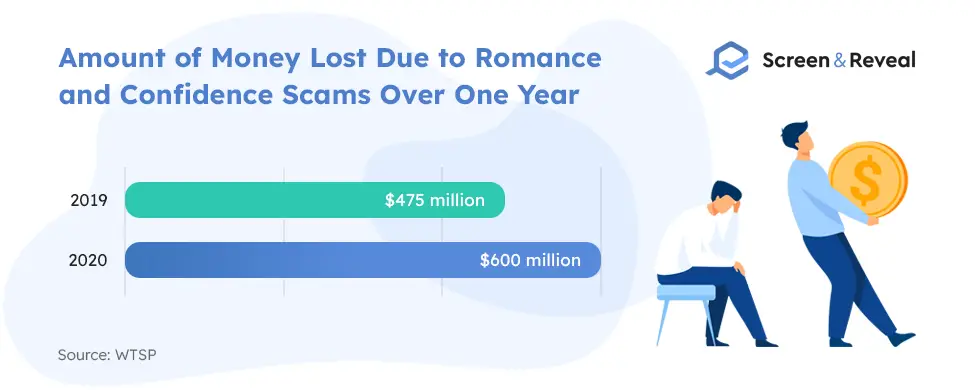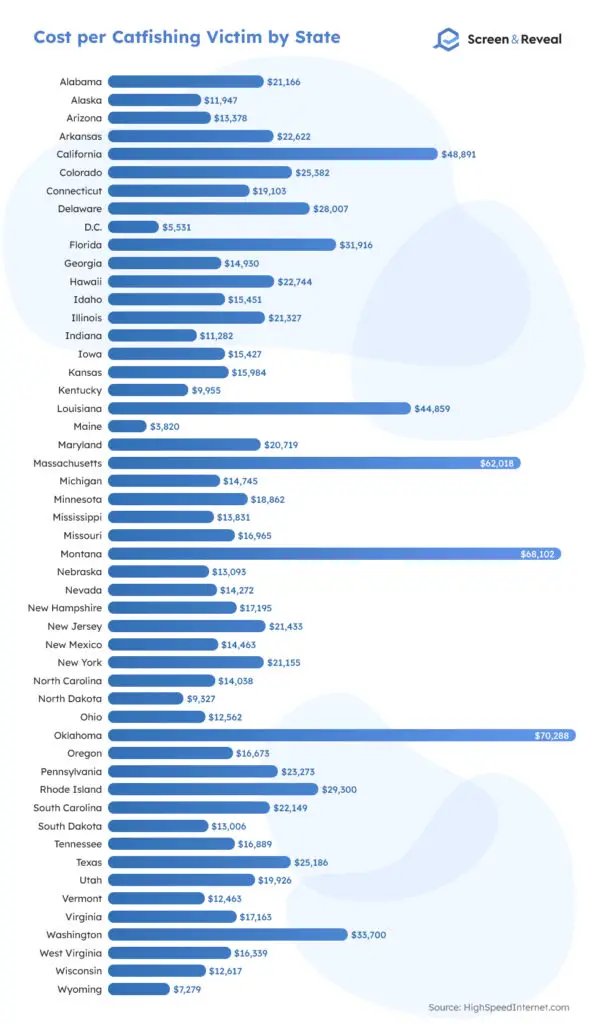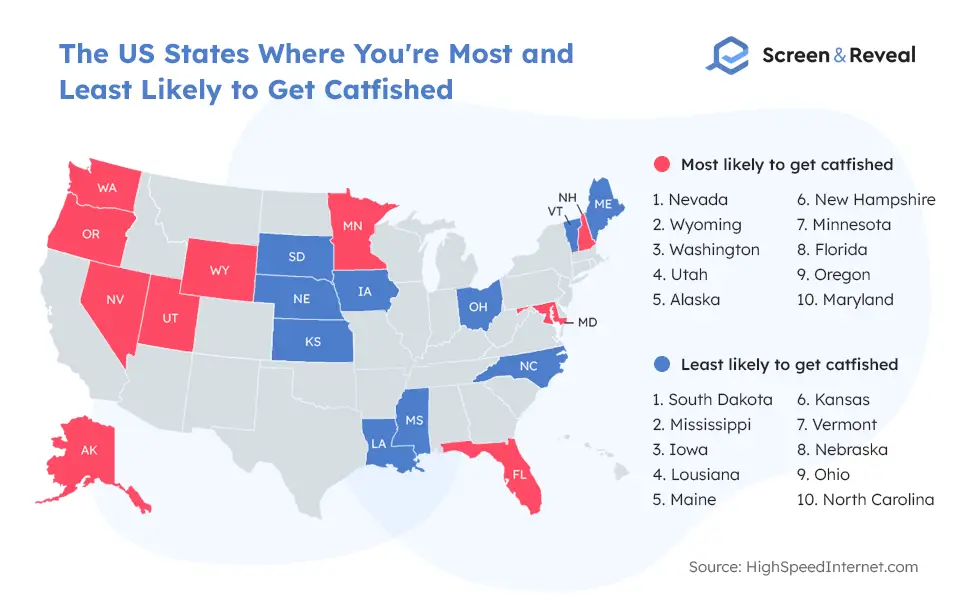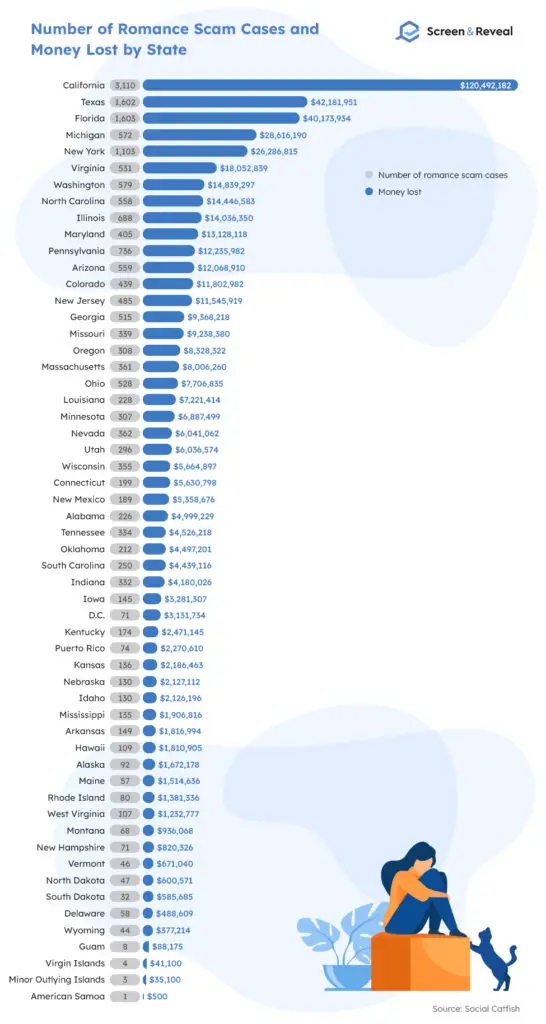Catfishing has become a part of everyone’s internet experience, and it occurs across countries, cultures, dating apps, and social media. It can be big business, too, with romance scams costing victims millions of dollars across the US every year. Current catfishing statistics project an even further upward curve over the coming years, and users should be vigilant of the dangers.
Catfishing Statistics (Editor’s Choice)
- Men are statistically more likely than women to catfish.
- Facebook has taken down 1.3 billion fake accounts in just six months.
- Catfishers cite loneliness as the biggest motivation for creating fake personas.
- Catfishing victims in Oklahoma lose more money than anywhere else in the US.
- Social media platforms have produced more romance scams than online dating sites.
- Romance scam incidents rose by 40% in 2020 amid the Coronavirus pandemic.
- The Nigerian prince scheme still makes over $700,000 a year.
- 27% of online daters in the UK reported catfishing.
Catfishing Facts & Stats
1. Men are slightly more likely to catfish someone than women.
Catfishing doesn’t foreground one gender disproportionately â both men and women are guilty of it. But statistically, it is men who are likely to commit the deed more often. One study also found that increased attachment anxiety is one of the major driving forces for individuals to become both a perpetrator and a target.
(ResearchGate)
2. One in five perpetrators will pretend to be someone of the opposite gender.
Around 24% of all catfishing perpetrators pose as a different gender. Many victims struggle to accept the truth, especially if they have formed a romantic attachment. Catfishing online dating statistics further indicate that men are more likely to lie about their finances when compared to women, while women lie more about age. Regardless of gender, 54% of online daters feel the person they talk to is using a fictional account. One way to verify if that’s true is to run the person’s name, last name, and other known details through people finder sites.
(FreeBackgroundChecks.com)
3. Facebook took down 1.3 billion fake accounts in three months.
In an audit of the social media giant, it was revealed that as many as 1.3 billion accounts on the world’s most popular platform were fake, making it a heaven for catfishers all over the world. Social media catfish statistics suggest that the platform’s astronomic user count perpetrated the problem significantly — prompting the company to form a task force with over 35,000 professionals that hunt misinformation as well as users who engage in catfishing on social media.
(Facebook)
4. 41% of catfishers cited loneliness as their motivation.
Though it’s difficult to imagine a life without an online presence, the ethics of online identities is quite a complex phenomenon as is the psychology of catfishing. Internet catfishing statistics rank psychologically distressing circumstances, such as loneliness or dissatisfaction with their physical appearance, as major driving forces that push people to assume a fictional identity online, often falling off the track.
(The Conversation)
5. In 2020, US catfishing victims lost over $600 million to romance scams.
According to an independent study FBI carried out, catfishing victims were taken for a costly ride by scammers, leading to over $600 million in a single year and up from the $475 million lost in 2019. Catfish facts suggest even more victims will lose money in the years to come with more of people’s lives moving online.
(WTSP)

6. Oklahoma is the state with the highest cost per catfishing case in the US.
On average, over the last few years, no other state has reported as many financial losses at the hands of catfishing or romance scams as Oklahoma. Victims of catfishing in the Sooner State lose $70,288 per case, 20 times more than victims in Maine who lose under $4,000 on average.
(HighSpeedInternet.com)

7. Catfishing victims per 100,000 residents in the US rose 52% from 2015 to 2019.
Statistics and facts about catfishing online suggest that the surge in this phenomenon maintains its upward curve â more in some places than others. According to a recent study, Nevada and Wyoming are the two states where people are most likely to fall victim to catfishing. At the same time, South Dakota and Mississippi were noted as the safest in this regard.
(HighSpeedInternet.com)

Catfishing and Online Dating: A Hellish Match
8. California was the most targeted state for romance scams in 2020.
The surge in mobile usage throughout the lockdown period resulted in catfishing online statistics going through the roof. With a total of 3,110 victims and a whopping $120 million lost, California received the worst blow from romance scam-themed catfishing, online dating numbers indicate. Texas, Florida, Michigan, and New York follow to round up the top five.
(Social Catfish)

9. Romance scams take place more on social media than on dating platforms.
Romance scams have become commonplace online, with catfishing on social media statistics suggesting that the vast majority of these cases occur on Facebook and Instagram. The number of catfish scams has nearly tripled since 2016, data shows.
(FTC)
10. There was a 40% increase in people trying to recover money lost to romantic scammers in 2020.
As the pandemic crept into our lives, it bloomed another epidemic — scammers flooded to online dating apps to exploit the general atmosphere of isolation and vulnerability. Statistics on catfishing indicate that Americans have lost more money to romance scams than any other type of deceit for the first time.
(AZ Big Media)
11. People aged between 20 and 29 saw the most spike in romance scam incidents.
While all ages experienced a surge recently, 20-somethings have seen the most dramatic increase. People ages 40 to 69 were most likely to suffer from romance scams, while people aged 70 or older reported the highest individual median loss of $9,457, as per online catfishing facts of 2020.
(FTC)
Catfishing Is Big All Over The World
12. The Nigerian prince scam still makes over $700,000 a year.
Accounting for perhaps the earliest incidents of en masse catfishing online, the Nigerian prince email took the world by storm in the late 1990s and early 2000s. The classic email involved a supposed prince who needs help transferring his wealth to an off-shore account and would reward whoever helps generously. As it seems, the organization behind it has started targeting the next generation.
(EBDAA)
13. Over 34% of Australians who report being catfished incurred financial loss.
The catfishing statistics Australia faces seem to be just as problematic as anywhere, with more than a third of all catfishing or romantic scam victims having lost money. Australians lost just shy of $2 million in March 2021 alone, only from 243 reported cases. This suggests that while the frequency of these scams isn’t as high as other places globally, Australians seem to take the hit in the bank balance.
(Australian Competition & Consumer Commission)
14. Canadians lost $18.5 million to romance scams in 2020.
Romance scams are among the ten most common types of fraud occurring in Canada and have cost victims a pretty penny over the last 12 months. The catfishing statistics Canada has produced in the previous year have raised some eyebrows, including those of the official banking association.
(Canadian Bankers Association)
15. 27% of online daters in the UK have been catfished.
The UK banking industry warned over half of dating site users about the surge in romantic scams and encouraged them to be more well-informed about the phenomenon. The rising catfishing statistics the UK has witnessed prompted both governmental and civil organizations to take action over the recent years.
(Infosecurity Group)
Catfishing FAQs
How many people have been catfished?
Catfishing is a global problem and affects millions of people. It’s almost impossible to tell how many people have ever been catfished. In the United States, catfishing is as bad as anywhere else, with Nevada, Wyoming, Washington, Utah, and Alaska as the top five offending states.
How many people get catfished a year?
It depends on the state. Some statistics on being catfished indicate some states are more vulnerable to catfishing and romance scams, with some victims losing around $70,000 per case. About 20,000 people a year get catfished though not all of them incur financial losses. In 2020, the FBI received 23,768 romance and confidence scam reports, up from 19,473 in 2019, and the pandemic is to blame as catfishers capitalize on people’s loneliness and lack of social life.
What are the dangers of being catfished?
Catfish statistics show that most catfishing is harmless, albeit deplorable, but there are instances where it can cause massive damage. The two main dangers of catfishing are emotional trauma and being defrauded or scammed. Identity theft statistics also show that often catfishers use tactics to retrieve sensitive information and ultimately steal victims’ identities. Some people lose thousands of dollars to romance scams, while the psychological effects of catfishing can cause emotional distress or trigger anxiety and depression.
Is it a crime to catfish someone?
In short, no. Though catfishing statistics paint an alarming picture, there is no law against catfishing or romance scams. The money that changes hands does so with the victims’ consent, and no crime is actually committed.
How did catfishing get its name?
Catfishing gets its name from the widely popular 2010 documentary Catfish. The husband of the perpetrator featured in the film found comparisons between the act and a myth about catfish — old fishers supposedly packed cod with it to keep the cod scared and moving, which made sure it stayed fresh.
Sources: ResearchGate, FreeBackgroundChecks.com, Facebook, The Conversation, WTSP, HighSpeedInternet.com, Social Catfish, FTC, AZ Big Media, EBDAA, Australian Competition & Consumer Commission Scamwatch, Canadian Bankers Association, Infosecurity Group.

